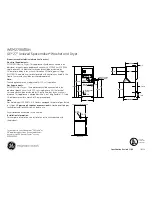
8
Salt
The hardness of the water varies from place to place. If hard water is used in the dishwasher, deposits
will form on the dishes and utensils.
The appliance is equipped with a special softener that uses a salt specifically designed to eliminate lime
and minerals from the water.
How to fill the salt
Loading the salt into the container
Always use salt intended for use with dishwashers.
The salt container is located beneath the lower rack and should be filled as follows:
Adjusting salt consumption
The dishwasher is designed to allow for adjusting the amount of salt consumed based on the hardness of
the water used. This is intended to optimize and customize the level of salt consumption so that it re-
mains at a minimum.
To adjust salt consumption, proceed as follows:
It is recommended that adjustments be made in accordance with the following table:
When the low salt indicator “1” lights, you must fill the salt.
Remove the lower rack and then unscrew and remove the cap
from the salt container;
If you are filling the container for the first time, fill it with water;
Place the end of the funnel (supplied) into the hole and introduce
about 2 kg of salt. It is normal for a small amount of water to
come out of the salt container.
Carefully screw the cap back on.
1
Important
To prevent the formation of rust, load the salt just before beginning a wash cycle.
U
nscrew the cap from the salt container;
There is a ring on the container with an arrow on it (see figure to
the side).
If necessary, rotate the ring in an anticlockwise direction from the
"-" setting towards the "+" sign, based on the hardness of the
water being used.
Water Hardness
Clarke
degrees
ºdH
mmol/l
Selector
position
Salt
c o n s u m p t i o n
(Grams/cycle)
Autonomy
(cycles/2kg)
0-14
0-17
0-1,7
1,8-4,4
18-44
14-36
36-71
45-89
4,5-8,9
>89
>71
>8,9
/
"-"
Middle
/
0
20
40
60
"+"
60
40
25
Level
1
2
3
4
en











































